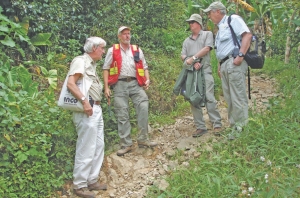Results from the first three holes from Seafield Resources’ (SFF-V) latest campaign at the Miraflores gold deposit in Colombia sent the company’s shares flying.
Seafield shares shot up 147% after releasing the news on Dec. 3 to finish the day at 57¢ on 70 million shares traded.
The fuss was primarily caused by hole 3, which assayed 449 metres grading 1.29 grams gold per tonne including 23.9 metres grading 9.18 grams gold.
The result, along with assays from two other holes, came out of the company’s Miraflores property at the Quinchia gold project in Risaralda, Colombia.
Seafield says Quinchia contains several porphyry and porphyry breccia open-pit targets including the breccia-style deposit at Miraflores.
The highlighted hole was drilled from the northeast contact to the southwest contact through the centre of the Miraflores porphyry breccia pipe body.
The deposit already has an inferred resource of 18.6 million tonnes grading 1.3 grams gold at a cutoff grade of 0.5 gram gold for a total of 776,000 oz. gold.
That resource estimate seems destined to grow in the future thanks to the new results, as the original estimate was based on 3,624 metres of drilling in 10 diamond drill holes carried out in 2006 and 2007, and 154 underground samples.
“With the best hole ever drilled on the Miraflores project, we are very optimistic that we will see an increase in the inferred resource,” said Anthony Roodenburg, Seafield Resources president and CEO, in a statement.
“Our continuing exploration and drilling on the other porphyry targets on our large property will allow us to further increase resources in the district,” he said.
One significant reason for Roodenburg’s optimism is that the current diamond drill program has thus far indicated that the breccia body is more extensive at depth than was inferred from previous drilling.
The company has drilled a total of 4,132 metres in 12 holes over the program, which was just recently completed.
The company describes Miraflores as a breccia body comprised of several variably mineralized, separate, intrusive porphyry breccia phases.
Stronger gold mineralization is associated with a later clean breccia phase which is cemented by vuggy quartz, carbonate and epidote associated with pyrite, sphalerite, chalcopyrite and galena with local visible gold.


Be the first to comment on "Seafield soars on Colombian gold hits"